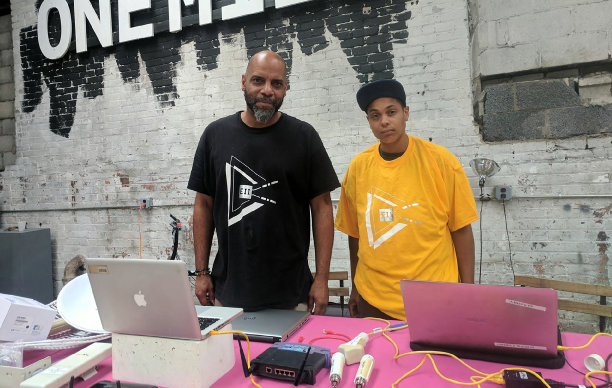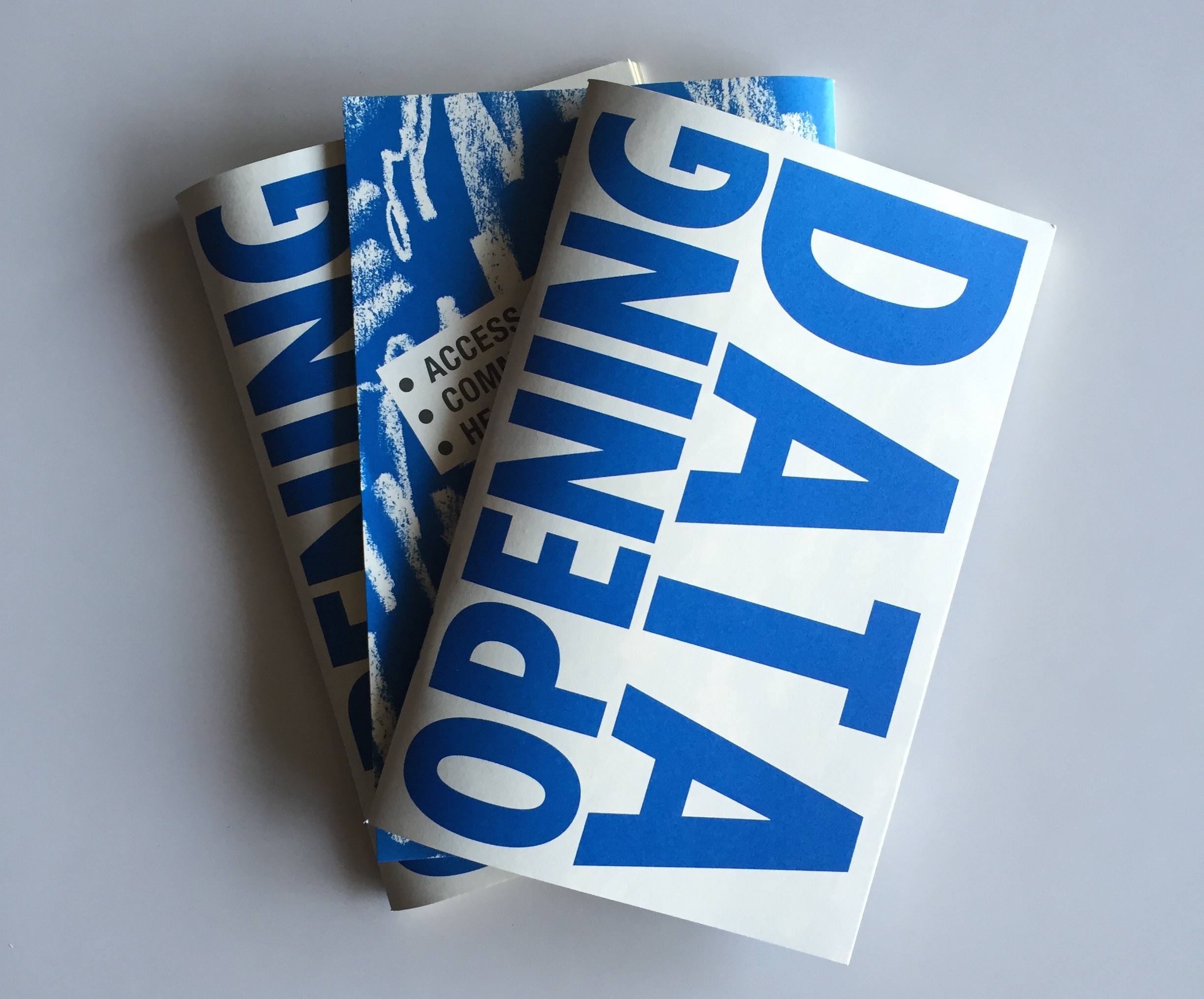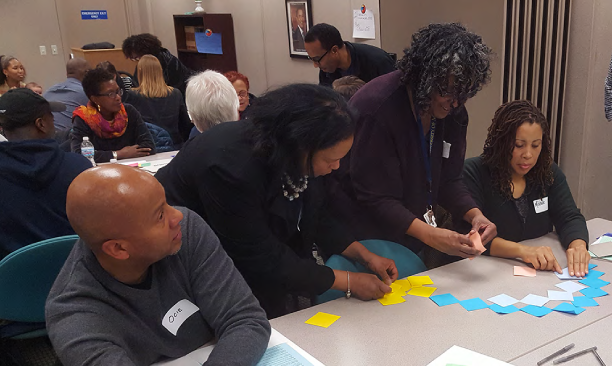
Digital stewards of DCTP Heru House and Gabrielle Knox. Photo via Jean Louis Farges. Image description: Two people stand behind a table covered with electronic equipment necessary to set up wireless internet. Photo courtesy DCTP.
I interviewed community researcher Tawana Petty and program coordinator Janice Gates from the Detroit Community Technology Project (DCTP). DCTP works around building digital media education and community technology in Detroit. DCTP was a featured vendor at the first ever New York Tech Zine Fair on Dec. 1 at the School for Poetic Computation.
Tell me a little bit about yourselves—who you are, what your role in DCTP is and what’s going on in your world.
Tawana: This is Tawana Petty. I am the data justice coordinator for the Detroit Community Technology Project as well as a data justice researcher. And I serve as a communications assistant. Currently, I maintain our social media profile as well as our research around data justice and some of the policies and things that are happening in the city around surveillance and technologies. I’m currently digging into our city infrastructure as well as Project Green Light and Census 2020 and convening our Detroit Digital Justice Coalition around organizing efforts on those three fronts. And I co-lead a three-city [Charlotte, North Carolina; Detroit, Michigan, and Los Angeles, California] participatory research project called Our Data Bodies which we will be launching a digital defense playbook through that effort. Those are my current roles within DCTP.
Can you tell me a little bit more about Project Green Light?
T: Project Green Light is this collaboration with the Detroit Police Department. It’s kind of like a mandate for businesses that are open late to have cameras installed that can be monitored by, not only the police department, but community members who are volunteer citizens that monitor these businesses for crime, essentially. I’m not really sure yet whether community members have this part of it as well, but officers have an app on their cell phone where they can then monitor from wherever they are. It’s essentially a ramped up method of surveillance under the guise of safety. What we are researching is whether or not surveillance creates safety. Although my research with the Our Data Bodies project shows an analysis between the three cities around surveillance not creating safety, but we want to make sure that with regard to this particular project that we have fresh research and fresh analysis, that we talk to the foundations that are funding this smart city infrastructure and these technologies and make sure that we can come out with our analysis backed up in such a way that brings all the voices into the fold. But because Detroit has suffered under a half century of propaganda assault and some community members have internalized that in maybe some function or particular way, as well as community members have internalized that who have not experienced crime, it’s easy to opt into things that create unsafe infrastructure. If you’re afraid and convinced to be afraid, then you’ll ask for the things that aren’t safe for you like surveillance.
I wanna talk more about that later, but first, I want to know a more about who you are, Janice.
Janice: My role at DCTP is I’m the coordinator for the Equitable Internet Initiative (EII). I really support the anchor organizations we work with on about three levels. I work with the project managers to plan for network sustainability, resiliency and staff management. Each anchor organization also has a network manager and those network managers plan the work of the stewards. So, I meet with them, really more around administrative and management support. And then, I work with the digital stewards to support them in building out the actual networks. I help coordinate more intensive technical trainings they might need—any documents or resources they don’t have, and provide logistical support for meetings, events and any activities involving the stewards. This year, we’re working on a plan to make the networks completely autonomous by the end of 2019 to were they won’t be so reliable on us for support, it’ll move more into a collective or a network.
Do you think it’s important to bridge the gap between the organizing and tech communities? Do you see these communities as separate in the first place? If so, why or why not?
T: It’s tremendously important to bridge the gap between the organizing and tech communities. It’s one of the reasons why I am, essentially, a social justice worker first and a technologist second. It’s very important, especially within research, to have that community, grassroots, organizing perspective because—I mean we’re all flawed, so you can’t give a guarantee, but—it’s the way that we bring community members into the fold when we’re making decisions and it’s the way that you know how to approach community about the things that they need versus parachuting in and creating things that aren’t going to serve the community. When you are an organizer, you tend to see yourself as part of the community and not someone that is apart from the community. So you’re making decisions not only for people that would be outside of your work, but yourself as well. When you look at it from that perspective, you use a co-liberatory framework instead of like, ‘hey, I’m an ally. I’m coming in. I’m going to help you do this thing,’ you’re looking at as ‘this is something that is going to best serve all of us.’ It’s a more holistic way of doing the work.
J: Which is part of the reason we included organizing in the digital stewards curriculum. So the students went through a 16 week training and they actually spent half of that time learning how to organize. We looked at organizing as a way to get residents in the communities to take more ownership of the network, which is why we spent a lot of time teaching the stewards how to do that. They’ve been using those organizing tools that they learned to work with the neighborhood advisory boards, set up community meetings and workshops, and a couple of the groups go door to door and get people to sign up for the network. It’s also how they educate them about what the network is, how far it extends, and the benefits of being part of the EII network.
You both emphasize passing on technical skills onto people within the community. What do you consider full autonomy?
T: [Sighs] I’ll let you take that one, Janice.
[Laughs]. It’s a big question.
J: I look at it as more than just being able to download at super fast speeds, but also like, thinking about what else can you create on this network that can benefit you, your family, or your community at large.
T: One of the significant things about EII and the work that Janice is doing within EII is that these are community members that are essentially working with their neighbors, within their neighborhoods. The things they’re doing within the Equitable Internet Initiative becomes more autonomous because they’re not consumers, this is something that they’re co-creating. This is something that they’re defining for their neighborhoods specifically, based on the needs they’re neighbors are telling them. They’re not just looking at this as ‘oh, I’m going to have this thing that’s exterior to me that I can then consume, consume, consume from.’ They’re looking at a cooperative, productive manner of how to create a more self determinant community. It’s really bigger than just having internet access.

Opening Data Zine by DCTP and the Detroit Digital Justice Coalition. Image description: Three zine printouts stacked on top of each other. The one on top reads “opening data” in big, bold, cyan capital letters in a sans serif font. Photo via Allied Media.
Yeah, absolutely. So far, you’ve released 5 or so zines with the Detroit Digital Justice Coalition. How does zine making fit into DCTP’s larger goal to use and develop technology that connects people back to each other and the earth?
T: Ashe. Great question. Anything we do and learn, we feel it’s important to pay forward. The zines provide an opportunity to share the information as well as train trainers within our community to produce the things we’re doing in such a way where people can take ownership of them, as Janice was saying earlier. Basically, we try to create the thing they need for self determination. The zines make it accessible, because, as you know, the reason why EII exists in Detroit is because more than 35 percent of the city doesn’t have access to broadband. We don’t want the information to sit and wait until community members have digital access, we want to make sure they have access to these tools at the very basic technical level, which we know, a zine is also technology. So not just digital infrastructure, but analog infrastructure as well.
J: It’s also shared with them in a way that’s easily accessible. In our zines, there’s not a lot of tech jargon that most people wouldn’t understand. I think there’s a zine coming out on how the internet works, which can be a very complicated thing to look at, but this zine breaks it down and lets people know how things work, like how is your information being used and where is it being used. It’s also about how it’s shared.
Let’s say DCTP decided to start working on a zine project today. What would that process be like?
T: Well, we normally lock each other together in a room for days and brainstorm our passions. Like, what’s the thing we think is important to bring to this creative process. Then we spend time working on that thing, and then we come together and streamline what we’ve created. Depending on the length of the zine, how complex it is or whether or not it’s going to be in the curriculum, we think about who can take particular lessons and flesh those out, what are some research and resources we need to look into and then we come back together. It’s a very collaborative process of brainstorming, co-creating content and then someone will do copyediting and someone will do design, but we’re collaborative all throughout the process.
As a black woman, I’m really curious about your personal relationships with technology and also what it’s like being surrounded by other black women within the collective, non profit, tech space that you’re in. How does that impact the work you do?
T: For me, it’s tremendous. It goes against the dominant narrative that black women are not technologists, that black women don’t have information around digital infrastructure, that we can’t teach technical skills, that we’re just not within this work. What is the significance of our data bodies? It’s tremendous to be so involved with black women and other women of color who are kicking ass in this work. Like I said, it defies all the narratives that have defined this work for so long and it’s empowering. It feels good to wake up everyday to know that I’m a part of this. J: It’s a very freeing space to be in, working with all women of color, especially leading this project. Because we’re not playing by anyone’s rules. We’re not doing technology the way everyone says or suggests it should be done. We’re showing people there’s a different way to do this.

DCTP Gigabit Workshop with Mozilla Foundation. Image courtesy the Detroit Community Technology Project.
It means a lot for me to see two black women doing the work that you do within tech. On that note, I want to talk about the statistic that 40 percent of people in Detroit don’t have internet access. It’s almost been a year since that statistic has been released. How have you seen your community change as a result of your efforts?
T: There’s definitely a bit of research on what our impact has been on that number. I can personally say, from the data justice perspective, the biggest impact I’ve seen is consciousness around who can access, who can create their own internet, who can be brought into this conversation, what capacity do we have to create cooperative infrastructure around technology. Whereas, if I were to try to pose this conversation five years ago, it would be more difficult and imagining black women in it would definitely not be a big part of the equation. I’ll also say, the work through the Digital Justice Coalition, for many years now, has been tremendous within collaborating on all these avenues and organizing the Data DiscoTechs which is short for ‘discovering technology.’ A lot of the folks that are now digital stewards have had some communication coming through the Data DiscoTechs or being at different Allied Media conferences. There’s been a long history of having the conversation, but EII being a very solid, sound infrastructure and example. Now we get to put the consciousness with the visible infrastructure. I can imagine that even if the percentage is small at this point, the potential is large because the consciousness has shifted. That’s the biggest part, having community members having the faith and courage that they can make this kind of impact.
J: Where I’ve seen it have impacts is among the digital stewards. A lot of them came only as technologists or organizers, and in watching the growth of how they’ve taken ownership over building wireless internet infrastructure, it’s more than just a job to many of them. They’re building relationships with residents on the network in a way that larger ISPs [Internet Service Providers] don’t.
What does a caring, digitally literate, consensual world look like to you?
T: Wow.
J: Hm.
T: Honestly, we’re not there yet, but we’re as close as one can get. I talk about this all the time—I work part time and there are days I don’t have to be here, but I find myself coming into this space voluntarily. I’ve been in a corporate world and I’ve been in this world. I would, as one of my late mentors would say, ‘we’re making the road by walking it.’ But it’s definitely a road I’m happy to be on. I think asking more questions, questioning whether we’re being consentful, questioning whether safety and security are synonymous or not. A lot of questioning and not accepting the status quo and imagining what we want to create. We actually innovate and create what we imagine on a daily basis which is not the freedom that a lot of other places have. Personally, I don’t know what that world would look like, but if we think about what it would look like, we start to build a curriculum around it.
I think that’s a beautiful point that you bring up, because you’re involved in organizing and surrounded by a community where you’re able to imagine the world you want to see on a daily basis, maybe your world already looks like that. People who are outside of organizing might have a different purview because they’re not surrounded by people making the changes they want to see. But you’re seeing the world through the lens of other organizers and people who are very much engaged in enacting the world they want to see.
J: I don’t know if either of you have seen Life of Pi, but there’s a point where Pi is on this island where he’s looking down into the water and the water’s green. He realizes the water is only green on that specific island, that that’s the only place it changes colors. I just feel like we’re kind of on that magical island. The water just needs to spread. We’ve laid the foundation, we’ve built the infrastructure, now we just need more digital stewards. I think this blend of technology and organizing will be responsible for spreading that type of magic.

